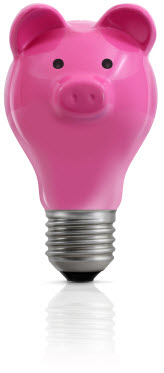Resources Helping Children Save Energy & Save Money
Energy efficiency can go a long way towards preserving our natural resources and promoting a clean environment, so it is important for kids to learn and practice energy conservation. There are many things that kids can do to save energy around their home. By simply turning off lights when leaving a room, recycling, and conserving water, everyone can make a huge difference in home energy saving. Use the following information and resources to learn more about energy efficiency and how you can make a difference.
Ways to Save Energy
Using less energy can have beneficial results financially, ecologically and personally. The average household uses 500 to 800 kilowatt-hours (kWh) per month. When energy-saving techniques are set in place, most families can expect to save 20-30 percent on their energy bill. Saving energy also reduces “greenhouse gas' emissions. In some parts of the world, such as South Africa, electricity is generated from coal-burning industries which emit carbon dioxide (CO2) into the environment. Greenhouse gas emissions also contribute to global warming. Burning of the coal used to create electricity, in addition to fuel combustion from vehicles, is responsible for a large portion of air pollution. Water is also used to generate electricity nearing 2-liters of water per energy unit of electricity. These are just a few of the reasons it's highly important that we save energy and our natural resources. There are many ways you can use less energy at home, such as: 
- Turn off lights and electronics (ex. televisions, computers, video-games, stereos and lamps) when you leave the room.
- Open your curtains or blinds on sunny winter days to allow the sun to shine in the house.
- Turn off the water while you brush your teeth and take short showers instead of baths.
- Set your home's thermostat several degrees lower. Families can save up to 5 percent for each one-degree change on your home's heating and cooling bill.
- Wait until after 8 pm. to use dishwashers, washing machines and dryers.
About Energy Efficient Appliances
Appliances are a major source of energy consumption in the home. Replacing older appliances with new energy-efficient models is not only beneficial to the environment, but also to your energy bills. Energy-efficient appliances reduce water consumption, greenhouse gas emissions and our reliance on foreign oil and fossil fuel resources. Owners of energy-efficient appliances also qualify for an energy tax credit. Therefore, while the initial cost of these appliances may be slightly higher, the payoff is well worth it. Energy-efficient appliance owners save an average of $400 per year.
- Keep the coils of the refrigerator and condenser area free of dust. Defrost freezers when the frost build-up is more than ¼-inch thick.
- Wash and dry full loads with appropriate water-level settings when cleaning clothes. Clean the dryer lint trap after every load.
- Allow your dishes to air-dry instead of using the dishwasher heat setting. During the summer months, use the dishwasher during the cooler times of the day.
- Use the burner that is closest to the pot size when cooking on the stove. Heat and energy is lost when the burner size is larger than the pot size.
- Replace regular incandescent light bulbs with compact florescent light (CFL) bulbs. For each bulb replaced, consumers can save about thirty dollars in energy costs over the life of the bulb.
Renewable Energy
Renewable energy is derived from various resources, such as the sun and wind. In the United States, renewable energy sources include hydro-power, biomass, geothermal wind and solar power and account for 8 percent of the countries energy. The majority of renewable energy sources go towards producing electricity. Renewable energy has many advantages and is a preferable alternative to non-renewable sources. They do not produce greenhouse gas emissions or cause air pollution. Unlike many sources of fossil energy, renewable energy does not require fuel and costs are becoming comparable to higher fossil fuels.
Biomass
- Biomass fuels, or biofuels, may be liquid, solid or gas and are derived from biomass feedstock. Energy in biomass can be transformed into heating, transportation or electricity generating fuels.
- Biomass fuels produce no sulfur emissions, minimizing global warming impacts and help mitigate acid rain.
- Biomass combustion produces less ash than traditional coal and reduces landfill space requirements. Biomass ash can be used on farm lands as a soil amendment.
Solar
- Solar energy requires little maintenance. Once solar panels or troughs are installed, there is no further work to keep the panels working efficiently.
- Environmental solar energy is quiet, clean and visually unobtrusive. They do not produce polluting emissions and do not make noise.
- Solar panels can be installed in virtually any geographical region as the sun is available everywhere. Uses little to no water in the generation of zero-emission electricity.
Wind
- During operation, wind turbines generate zero pollution. Wind turbines can compete with fossil fuels in terms of installed costs.
- Wind turbines are created in a wide range of sizes. Therefore, they can provide energy for single-family homes, commercial facilities or entire towns or cities.
- Unlike many conventional sources of energy, such as coal and natural gas, water consumption from wind energy is significantly less.
Geothermal
- Geothermal energy is very clean and produces little emissions. It takes natural heat from the Earth and cycles it through heat pump technology.
- The geo-exchange system used to generate geothermal energy is healthy, safe and clean. There is no open flame or venting requirement, therefore no risk of carbon monoxide poisoning or explosions.
- Geothermal energy is a reliable alternative source of energy. For homeowners, the use of this energy can also mean substantial savings.
Additional Reading
